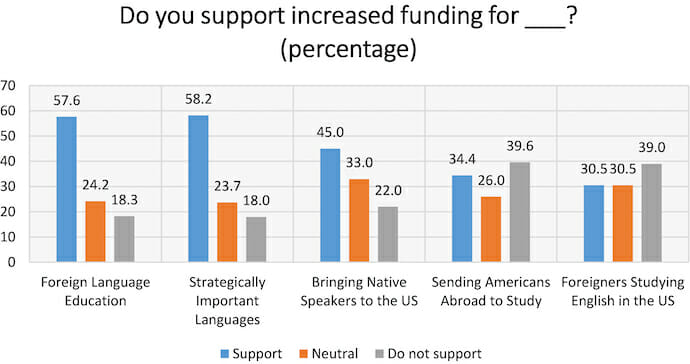
Do Americans Support Funding for Foreign Language Education?
Educators, journalists, and researchers have been concerned with the dismal state of language education in the U.S. for years. A 2018 survey of students found that in Europe, a median of 92% are learning at least one foreign language, while in the U.S., only 20% are. Additionally, a 2006 General Social Survey showed only 0.7% of Americans who speak a language other than English well learned that language in school.
In recent years, language education programs have seen further decreases in funding, particularly as schools tightened budgets during the 2008 recession. With decreases in funding, it is impossible to fight the other problems embedded in the U.S. language education system, such as the lack of qualified teachers and the ineffectiveness of most language programs. These trends are concerning to many professionals in language education, and based on declines in funding and enrollment, it may appear that the American public is uninterested in language learning. However, public opinion research suggests that this is not the case.
To evaluate public support for language education, a survey of 1,027 Americans was completed in July 2020, recruiting respondents via Amazon mTurk. Each respondent was randomly assigned one of five prompts about increased funding for foreign language study.
- Version 1: Foreign language education in general.
- Version 2: Program emphasizing strategically important foreign languages.
- Version 3: Programs that bring native speakers of foreign languages to the U.S. to teach.
- Version 4: Programs sending Americans abroad to study foreign languages.
- Version 5: Programs bringing citizens of other countries to the U.S. to study English.
The results show that a majority of Americans—nearly 60%—support increased funding for language education. The levels of support are very similar between general foreign language and strategically important languages, indicating that most Americans do not differentiate between those language categories. This is somewhat surprising given both the existing government programs for funding such languages and the clear need for more government translators proficient in strategically important languages.

Additionally, while Version 3 received more support than opposition, suggesting respondents are aware learning from a native speaker of the language can have benefits, they oppose sending Americans abroad to study (Version 4). But studying abroad in an immersive environment will provide students with far more input from native speakers, suggesting that here too there are additional factors at play. The benefits of immersion, while not equal across age groups, are commonly touted as the best method of language learning. Yet this suggests that either such rhetoric has not reached most Americans or that they are skeptical of the benefits of interactions with native speakers of a language.
Democrats favored increasing funding far more than Republicans. On average, there was a difference of 27.13 percentage points between the two parties’ “support” totals. This fits with the parties’ overall views towards funding education. But the two groups still followed a similar trend in their answers. In Versions 3-5, Democrats increasingly selected the neutral option, while Republicans increasingly did not support the policy. In Version 5, the difference in the percent of each party was lowest (17.69%). This indicates that although Democrats are more supportive overall, both the location and the recipient of the funding in question affects the perception of members of both parties. Both groups have a clear preference for funding Americans studying in America.
While government organizations that bring foreign nationals to the U.S. to study recognize many benefits, both culturally and economically, the impact of such programs is indirect and thus may be less apparent to most Americans, decreasing support for this type of funding. Additionally, support for improving language education may be low when compared to the desire for funding in other fields, and many politicians have increasingly emphasized the need for more funding and focus on STEM programs over the liberal arts.
Of course, these issues are not unique to the U.S. China, for instance, has made English mandatory from third grade, but overall English proficiency there is still quite low even among those who are actively studying English. In the UK, only 32% of those 16-30 know a foreign language well enough to write it despite being geographically close to many countries that speak other languages. Still, that number is notably higher than the 10% to 20% of Americans who speak a second language.
Those inclined to defend America’s poor language education offer defenses such as America’s geographic isolation and the fact that people elsewhere are learning English. However, as many language education advocates have argued, in a more globalized society, language education should be increasing, not decreasing. There are more concrete reasons to encourage language learning as well: Americans who speak other languages are in high demand and stand to have high incomes, and companies in need of bilingual workers will have a broader pool of potential candidates to match their needs. This survey offers hope that Americans may not be as opposed to improving language education as expected—provided, of course, that the funding supports Americans in America.

